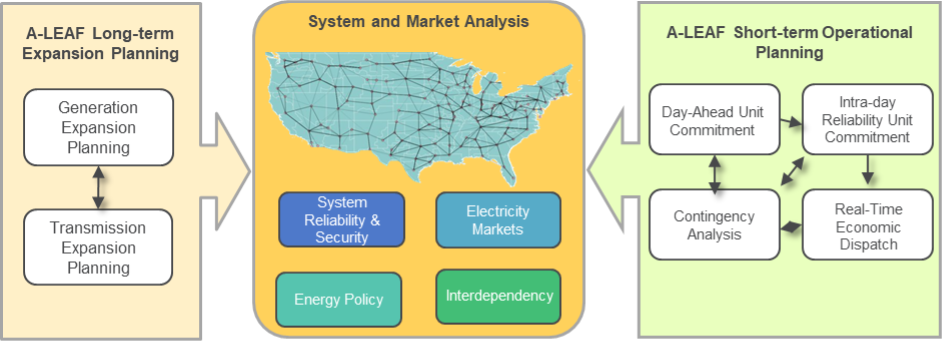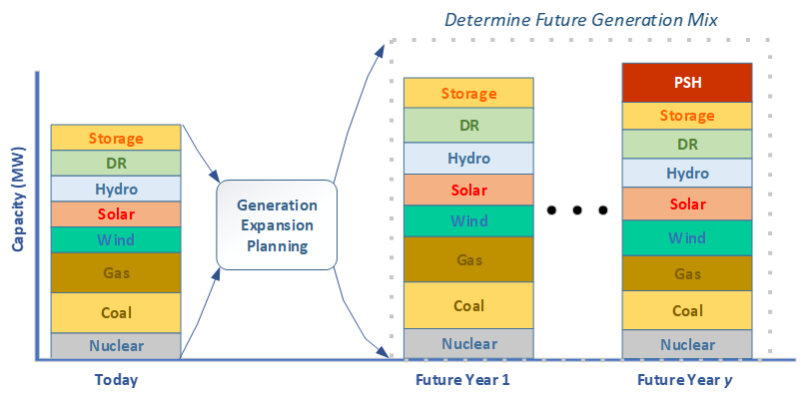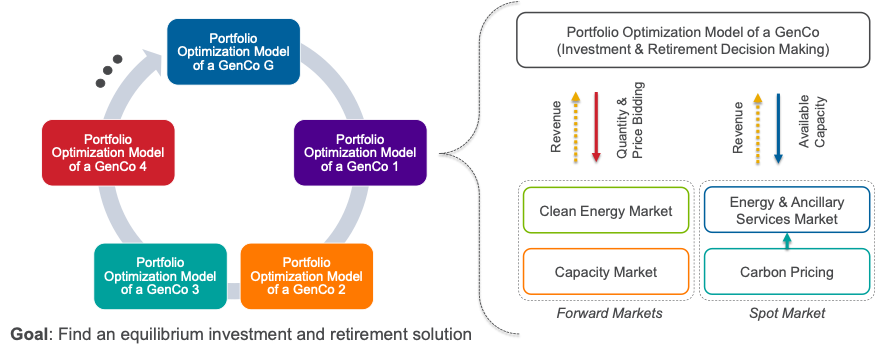Power System Modeling with A-LEAF: The Argonne Low-carbon Electricity Analysis Framework
A-LEAF is an integrated national-scale power system simulation framework that includes a suite of capacity expansion, unit commitment, and economic dispatch models. A-LEAF can determine the least-cost generation investment and retirement plans, transmission investment plans, and hourly or sub-hourly system scheduling all under a range of user-defined input assumptions for technology characteristics, electricity demand profiles, system requirements, and electricity market designs. In addition, the Strategic Capacity Investment Model (SCIM) that is part of A-LEAF that simulates interactions between profit-seeking electricity market participants to understand how competitive market outcomes may differ from centrally planned system least-cost solutions.
Long-term Expansion Planning
A-LEAF includes a long-term generation and transmission expansion planning model, which is a least-cost linear program. This can be used to determine the time, location, and size of new generation and transmission assets in a system over a multi-year planning horizon while ensuring that the total expected cost of power supply is minimized.
The least-cost objective function includes the costs of new generation investment and retirement, fixed and variable operation and maintenance, fuel, involuntary load curtailment, and applicable policy-related incentives or requirements. System costs are minimized while considering constraints related to serving electricity demand, meeting resource adequacy targets, maximum and minimum regional generation investments, technical characteristics of generating and storage resources, and policies and regulations.
Power System Expansion
A-LEAF determines the time, location, and size of new generation and transmission assets while considering the time-varying resource potentials of renewable energy resources such as wind and solar. In addition, the model considers the age-based retirement of existing generators while making investment decisions for new assets. A-LEAF also considers the possibility of retiring existing generation units to reduce total system costs over the analyzed time horizon.
Power System Operations
A security-constrained economic dispatch (SCED) problem is solved in A-LEAF to determine the optimal dispatch of generation and energy storage assets as well as the optimal procurement of required ancillary services. The economic dispatch formulation includes constraints for load balance, power flow and transmission limits, operating reserve requirements, and generator operating limits. The load balance constraints ensure that enough power is supplied to meet the demand in each region in each time interval. Power flows can be explicitly modeled with a direct current optimal power flow representation or alternatively they can be constrained by the aggregate transfer capability between regions. Lastly, A-LEAF schedules operating reserves to meet system requirements while respecting the operating limits of generation resources.
Technical and Operational Characteristics of Energy Storage
A-LEAF includes a detailed representation of the physical and operational constraints of energy storage resources. The model allows energy storage resources to provide capacity, energy, and operating reserves. Modelers can define the storage capacity of storage resources in the system, or A-LEAF can endogenously determine the optimal capacities of new storage assets. In addition, A-LEAF manages the state-of-charge levels of energy storage resources while respecting the chronological interactions of charging and discharging schedules. The total amount of energy an energy storage resource can deliver over a year may be restricted in A-LEAF by an energy throughput constraint. This constraint is a proxy for capturing cycle life specifications of energy storage resources, particularly battery storage technologies.
Policy and Regulations
A-LEAF can model a range of policies and regulations including technology-specific incentives such as an investment or production tax credit, renewable portfolio standards, limits on various emissions, and an internalized cost of carbon.
Strategic Capacity Investment Model
A-LEAF also includes SCIM, a game theory based model that simulates the future generation portfolios considering the investment and retirement decision-making of profit-seeking generation companies (GenCos). SCIM captures the strategic interactions between profit-maximizing GenCos in their portfolio optimization decisions within a Stackelberg Leader-follower game framework. The portfolio optimization model of a profit-seeking GenCo in SCIM determines the optimal investment and retirement decision for each GenCo based on anticipated revenues from forward and spot markets. SCIM is a valuable tool in assessing the effectiveness of wholesale market designs in incentivizing adequate investments from profit-seeking entities via market signals.
Short-term System Operations
A-LEAF includes a short-term security-constrained unit commitment (SCUC) model that optionally includes binary unit commitment status (on/off) when determining the least-cost system dispatch strategy. Considering unit commitment status introduces numerous additional binary or integer variables into the problem formulation and can greatly increase computational complexity. The SCUC model solves a mixed integer linear programming problem that includes several additional constraints compared to the SCED model, including minimum unit up- and down-times.


